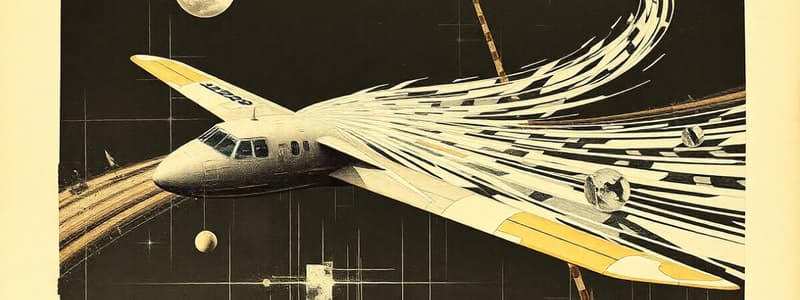Podcast
Questions and Answers
According to the Bernoulli principle, what happens to the static pressure of a fluid as its speed increases?
According to the Bernoulli principle, what happens to the static pressure of a fluid as its speed increases?
- The static pressure fluctuates.
- The static pressure decreases. (correct)
- The static pressure remains constant.
- The static pressure increases.
The Bernoulli principle applies to all fluids, including viscous ones.
The Bernoulli principle applies to all fluids, including viscous ones.
False (B)
What is the name given to the curved shape of an aircraft wing that is designed to create lift?
What is the name given to the curved shape of an aircraft wing that is designed to create lift?
airfoil
In an atomizer, a low-pressure area is created using compressed air, which then draws in a ______.
In an atomizer, a low-pressure area is created using compressed air, which then draws in a ______.
Match the following applications with the corresponding principle they utilize:
Match the following applications with the corresponding principle they utilize:
What are the key quantities directly related in Bernoulli's equation?
What are the key quantities directly related in Bernoulli's equation?
The Bernoulli principle states that a decrease in fluid speed results in a decrease in static pressure.
The Bernoulli principle states that a decrease in fluid speed results in a decrease in static pressure.
Name one other sporting equipment that utilizes the Bernoulli principle
Name one other sporting equipment that utilizes the Bernoulli principle
Flashcards
Bernoulli's Principle
Bernoulli's Principle
The Bernoulli principle states that as the speed of a fluid increases, its static pressure decreases.
Energy Transformation in Bernoulli's Principle
Energy Transformation in Bernoulli's Principle
Pressure energy is converted into kinetic energy as a fluid speeds up.
Bernoulli's Principle Simplified
Bernoulli's Principle Simplified
The Bernoulli principle states that as the speed of a fluid increases, its static pressure decreases. This is due to the conservation of energy, as pressure energy is converted into kinetic energy.
Bernoulli's Principle Applied to Aircraft Wings
Bernoulli's Principle Applied to Aircraft Wings
Signup and view all the flashcards
Bernoulli's Principle and Blood Flow
Bernoulli's Principle and Blood Flow
Signup and view all the flashcards
Bernoulli's Principle and Atomizers
Bernoulli's Principle and Atomizers
Signup and view all the flashcards
Bernoulli's Equation
Bernoulli's Equation
Signup and view all the flashcards
Limitations of Bernoulli's Principle
Limitations of Bernoulli's Principle
Signup and view all the flashcards
Study Notes
Basic Concepts of the Bernoulli Principle
- The Bernoulli principle states that an increase in the speed of a fluid occurs simultaneously with a decrease in static pressure or a decrease in the fluid's potential energy.
- The conservation of energy principle is fundamental to understanding the principle. As a fluid accelerates, some of its pressure energy transforms into kinetic energy.
- The principle assumes an ideal fluid: incompressible and non-viscous, with steady flow.
- The principle has broad applications across various scientific and engineering fields.
Applications of Bernoulli's Principle
- Aircraft wings: Airfoils create differing air speeds above and below the wing; faster airflow over the curved upper surface results in lower pressure, generating lift.
- Blood flow: Pressure variations influence blood flow in the circulatory system; changes in vessel diameter affect blood velocity due to Bernoulli's effects.
- Atomizers: Compressed air forced through a small opening creates a low-pressure area, drawing liquid into the air stream and forming a spray.
- Venturi meter: Liquid flowing through a constricted section (venturi) creates a localized pressure drop; the pressure difference measures flow rate.
- Spray nozzles: Flow rate and pressure differences control spray pattern and droplet size.
- Sports equipment: Bernoulli's principle impacts object flight paths; it's relevant to the flight characteristics of items like golf and tennis balls.
Mathematical Formulation of the Principle
- Bernoulli's equation mathematically expresses the principle of energy conservation for flowing fluids, relating pressure, velocity, and elevation.
- The equation is: P₁ + ½ρv₁² + ρgh₁ = P₂ + ½ρv₂² + ρgh₂
- P is pressure
- ρ is fluid density
- v is fluid velocity
- g is acceleration due to gravity
- h is height above a reference point
- Subscripts 1 and 2 represent different points along the flow.
Limitations of the Principle
- The Bernoulli principle is an idealized model, assuming an ideal fluid (no viscosity). Real fluids have viscosity, affecting flow.
- The principle assumes incompressible fluids. Highly compressible fluids (like gases) require incorporating density changes, leading to more complex calculations.
- The principle assumes steady flow. Fluctuating or turbulent flow isn't accurately modeled.
Relationship between Pressure, Velocity, and Altitude
- Higher fluid velocity correlates with lower static pressure, maintaining constant total head along a streamline.
- Total head combines static pressure, kinetic pressure (due to motion), and potential energy.
- Bernoulli's principle highlights the inverse relationship between kinetic pressure and static pressure; faster flow necessitates a lower static pressure.
Studying That Suits You
Use AI to generate personalized quizzes and flashcards to suit your learning preferences.




